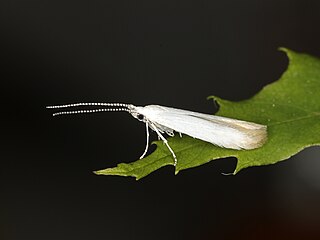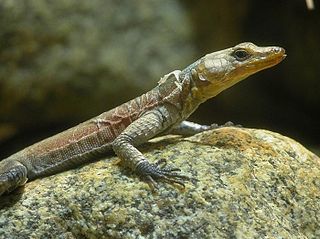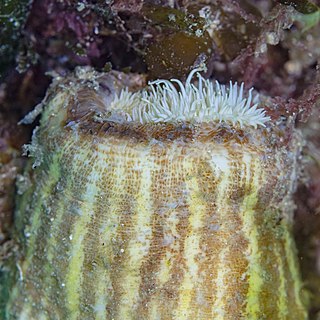
The pathogenic fungus Cryphonectria parasitica is a member of the Ascomycota. This necrotrophic fungus is native to East Asia and South East Asia and was introduced into Europe and North America in the early 1900s. The fungus spread rapidly and caused significant tree loss in both regions.

Apocrita is a suborder of insects in the order Hymenoptera. It includes wasps, bees, and ants, and consists of many families. It contains the most advanced hymenopterans and is distinguished from Symphyta by the narrow "waist" (petiole) formed between the first two segments of the actual abdomen; the first abdominal segment is fused to the thorax, and is called the propodeum. Therefore, it is general practice, when discussing the body of an apocritan in a technical sense, to refer to the mesosoma and metasoma rather than the "thorax" and "abdomen", respectively. The evolution of a constricted waist was an important adaption for the parasitoid lifestyle of the ancestral apocritan, allowing more maneuverability of the female's ovipositor. The ovipositor either extends freely or is retracted, and may be developed into a stinger for both defense and paralyzing prey. Larvae are legless and blind, and either feed inside a host or in a nest cell provisioned by their mothers.

Cladonia is a genus of moss-like lichens in the family Cladoniaceae. They are the primary food source for reindeer/caribou. Cladonia species are of economic importance to reindeer-herders, such as the Sami in Scandinavia or the Nenets in Russia. Antibiotic compounds are extracted from some species to create antibiotic cream. The light green species Cladonia stellaris is used in flower decorations.

Murphy's petrel is a species of seabird and a member of the gadfly petrels. The bird is 15 inches in length, with a 35-inch wingspan and weigh about 13 ounces. It does not exhibit sexual dimorphism. It was described by Robert Cushman Murphy in 1949, which is the source of the species' common name.

Hyaloperonospora parasitica is an oomycete from the family Peronosporaceae. It has been considered for a long time to cause downy mildew of a variety of species within the Brassicaceae, on which the disease can cause economically important damage by killing seedlings or affecting the quality of produce intended for freezing. Hyaloperonospora parasitica causes downy mildew on a wide range of many different plants. It belongs to the Kingdom Chromista, the phylum Oomycota, and the family Peronosporaceae. The former name for H. parasitica was Peronospora parasitica until it was reclassified and put in the genus Hyaloperonospora. It is an especially vicious disease on crops of the family Brassicaceae. It is most famous for being a model pathogen of Arabidopsis thaliana which is a model organism used for experimental purposes. Accordingly, the former Hyaloperonospora parasitica has been split into a large number of species. For instance, the taxonomically correct name of the parasite of the well-known model organism Arabidopsis thaliana is Hyaloperonospora arabidopsidis, not H. parasitica, whereas the pathogen of Brassica has to be called Hyaloperonospora brassicae.

A species that is extinct in the wild (EW) is one that has been categorized by the International Union for Conservation of Nature as only consisting of living members kept in captivity or as a naturalized population outside its historic range. Classification requires exhaustive surveys conducted within the species' known habitat with consideration given to seasonality, time of day, and life cycle. Once a species is classified as EW, the only way for it to be downgraded is through reintroduction.

The chestnut casebearer moth is a species of moth in the family Coleophoridae. It is endemic to the United States, where it is found in Indiana, Massachusetts, Pennsylvania, and Virginia. It is a highly specialized species, its larvae feed specifically on the leaves of the American Chestnut. It was thought the species became extinct when many American chestnut trees died due to an infection of the fungus Cryphonectria parasitica, which was accidentally introduced from Asia around 1900. However, this species was rediscovered.
Pheidole parasitica is a species of ant in the subfamily Myrmicinae. It is endemic to India.

Aquilaria crassna is a species of plant in the Thymelaeaceae family. It is critically endangered and native to Southeast Asia.

Aquilaria malaccensis is a species of plant in the family Thymelaeaceae. It is found in Bangladesh, Bhutan, India, Indonesia, Laos, Malaysia, Myanmar, the Philippines, Singapore, also Thailand. It is threatened by habitat loss.

The Pungwe flat lizard is a species of lizard in the Cordylidae family.

The copperband butterflyfish, also known as the beaked coral fish, is found in reefs in both the Pacific and Indian Oceans. This butterflyfish is one of the three species that make up the genus Chelmon and all have long beaks.

Stegastes diencaeus, the longfin damselfish, is a damselfish in the family Pomacentridae from the Western Atlantic. It occasionally makes its way into the aquarium trade. It grows to a size of 12.5 cm in length. Longfin damselfish have been reported to have a mutualistic relationship with mysid shrimp of the species Mysidium integrum. The interaction is described as a form of domestication with the shrimp providing nutrients for the algae farms the fish feed on and the fish providing protection from predators.
Hypovirus is a genus of viruses, in the family Hypoviridae. Fungi serve as natural hosts. There are four species in this genus. Infection reduces the virulence of its parasitic host, making it a hyperparasite useful for blight control.

Calliactis parasitica is a species of sea anemone associated with hermit crabs. It lives in the eastern Atlantic Ocean and Mediterranean Sea at depths between the intertidal zone and 60 m (200 ft). It is up to 10 cm × 8 cm in size, with up to 700 tentacles, and is very variable in colour. The relationship between C. parasitica and the hermit crab is mutualistic: the sea anemone protects the hermit crab with its stings, and benefits from the food thrown up by the hermit crab's movements.

Manica is a genus of ants within the subfamily Myrmicinae. To date it contains seven known species.

Eutropis longicaudata, the longtail mabuya or long-tailed sun skink, is a species of skink. It is found in southern China, Hong Kong, Taiwan, Laos, Vietnam, Thailand, Cambodia, and Peninsular Malaysia.

Encephalartos pterogonus is a species of cycad that is native to Mount Mruwere and adjacent mountains in the Manica province of Mozambique.

Cladonia parasitica, commonly known as the fence-rail cladonia, fence-rail cup lichen or parasite club lichen, is a species of fruticose, cup lichen in the family Cladoniaceae. It was first described by Hoffmann in 1784 under the name Lichen parasiticus, until he reclassified it under the genus Cladonia in 1795.


















